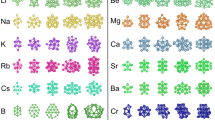Abstract
The structures of small Lennard-Jones clusters (local and global minima) in the range n = 30 - 55 atoms are investigated during growth by random atom deposition using Monte Carlo simulations. The cohesive energy, average coordination number, and bond angles are calculated at different temperatures and deposition rates. Deposition conditions which favor thermodynamically stable (global minima) and metastable (local minima) are determined. We have found that the transition from polyicosahedral to quasicrystalline structures during cluster growth exhibits hysteresis at low temperatures. A minimum critical size is required for the evolution of the quasicrystalline family, which is larger than the one predicted by thermodynamics and depends on the temperature and the deposition rate. Oscillations between polyicosahedral and quasicrystalline structures occur at high temperatures in a certain size regime. Implications for the applicability of global optimization techniques to cluster structure determination are also discussed.
Similar content being viewed by others
References
P. M. Ajayan and L. D. Marks, Experimental evidence for quasimelting in small particles, Phys. Rev. Letters 63 (1989), 279–282.
C. L. Briant and J. J. Burton, Molecular dynamics study of the structure and thermodynamic properties of argon microclusters, J. Chem. Phys. 63 (1975), 2045–2058.
J. Farges, M. F. De Feraudy, B. Raoult, and G. Torchet, Noncrystalline structure of argon clusters. II. Multilayer icosahedral structure of Ar N clusters 50 < N < 750, J. Chem. Phys. 84 (1986), 3491–3501.
J. Farges, M. F. Feraudy, B. Raoult, and G. Torchet, Noncrystalline structure of argon clusters. 1. Polyicosahedral structure of Ar N clusters, 20 < N < 50, J. Chem. Phys. 78 (1983), 5067–5080.
I. A. Harris, R. S. Kidwell, and J. A. Northby, Structure of charged argon clusters formed in a free jet expansion, Phys. Rev. Letters 53 (1984), 2390–2393.
M. R. Hoare, Structure and dynamics of simple microclustero, Adv. Chem. Phys. 40 (1979), 49.
M. R. Hoare and P. Pal, Physical cluster mechanics: Statics and energy surfaces for monatomic systems, Adv. Phys. 20 (1971), 161–196.
C. D. Maranas and C. A. Floudas, A global optimization approach for Lennard-Jones microclusters, J. Chem. Phys. 97 (1992), 7667–7678.
C. D. Maranas and C. A. Floudas, A deterministic global optimization approach for molecular structure determination, J. Chem. Phys. 100 (1994), 1247–1261.
D. J. McGinty, Molecular dynamics studies of the properties of small clusters of argon atoms, J. Chem. Phys. 58 (1973), 4733–4742.
N. Metropolis, A. W. Rosenbluth, M. N. Rosenbluth, A. H. Teller, and E. Teller, Equation of state calculations by fast computing machines, J. Chem. Phys. 21 (1953), 1087–1092.
J. A. Northby, Structure and binding of Lennard-Jones clusters: 13 < N < 147, J. Chem. Phys. 87 (1987), 6166–6177.
B. Raoult, J. Farges, M. F. De Feraudy, and G. Torchet, Comparison between icosahedral, decahedral and crystalline Lennard-Jones models containing 500 to 6000 atoms, Phil. Magazine B 60 (1989), 881–906.
J. P. Rose and R. S. Berry, (KCl) 32 and the possibilities for glassy clusters, J. Chem. Phys. 98 (1993), 3262–3274.
D. G. Vlachos, L. D. Schmidt, and R. Aris, Structures of small metal clusters: I Low temperature behavior, J. Chem. Phys. 96 (1992), 6880–6890.
D. G. Vlachos, L. D. Schmidt, and R. Aris, Structures of small metal clusters: II Phase transitions and isomerization, J. Chem. Phys. 96 (1992), 6891–6901.
L. T. Wille, Minimum-energy confiqurations of atomic clusters: New results obtained by simulated annealing, Chem. Phys. Letters 133 (1987), 405–410.
M. M. Zacharias and D. G. Vlachos, Simulated annealing calculations for optimization of nanoclusters: The roles of quenching, nucleation, and isomerization in cluster morphology, in Global minimization of nonconvex energy functions: Molecular conformation and protein folding, edited by P. M. Pardalos, D. Shalloway, and G. Xue, Vol. 23, (AMS, 1996), p. 251–271.
Author information
Authors and Affiliations
Rights and permissions
About this article
Cite this article
Vlachos, D. Growth of Nanophase Clusters and Potential Energy Minima: Hysteresis, Oscillations, and Phase Transitions. Journal of Global Optimization 11, 69–82 (1997). https://doi.org/10.1023/A:1008280510443
Issue Date:
DOI: https://doi.org/10.1023/A:1008280510443




